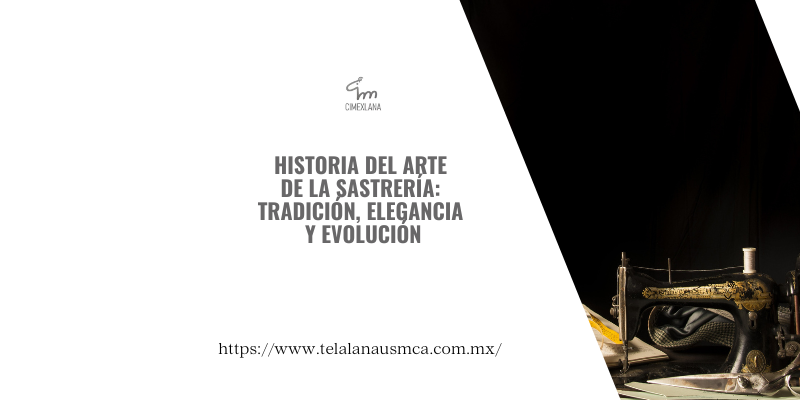
History of the Art of Tailoring: Tradition, Elegance and Evolution
Introducción
La sastrería es mucho más que una técnica de confección de ropa. Es un arte milenario que combina creatividad, precisión y un profundo conocimiento de la anatomía humana y los tejidos en tela de lana. Desde sus orígenes en los gremios medievales hasta la sofisticación de los trajes a medida actuales, la historia del arte de la sastrería representa un viaje a través del tiempo, el estilo y la innovación.
Orígenes de la Sastrería: Los Primeros Gremios
La sastrería tiene sus raíces en la Edad Media, alrededor del siglo XIII, cuando aparecieron los gremios de sastres en Europa. Estos artesanos tenían la importante tarea de confeccionar ropa a la medida para la nobleza, clérigos y personas de alto estatus social. En una época en la que la vestimenta definía el rango social, contar con un traje hecho a mano era símbolo de poder y distinción. Cada prenda era elaborada manualmente, con técnicas que requerían un alto grado de habilidad y precisión.
Herramientas y Técnicas Iniciales
Los primeros sastres utilizaban tijeras de hierro, agujas largas y rudimentarias, así como telas pesadas como lana y lino. Los patrones se elaboraban de forma manual y cada pieza se ajustaba directamente sobre el cuerpo del cliente, creando prendas únicas y personalizadas.
Renacimiento y Barroco: Elegancia en la Corte
Durante el Renacimiento y el Barroco (siglos XV al XVII), la vestimenta adquirió un papel aún más protagónico. Los sastres de las cortes reales creaban trajes elaborados con bordados, encajes y telas lujosas como la seda.
El trabajo del sastre pasó de ser una simple confección a un arte decorativo, incorporando detalles ornamentales que reflejaban el estatus social y el gusto estético de la época.
Siglo XIX: La Revolución de la Sastrería Moderna
El siglo XIX marcó un antes y un después con la Revolución Industrial. La invención de la máquina de coser y la disponibilidad de nuevos tejidos cambiaron la forma de confeccionar la ropa. Sin embargo, la sastrería artesanal no perdió relevancia; al contrario, se perfeccionó.
Savile Row: Cuna del Traje a Medida
En Londres, la famosa calle Savile Row se convirtió en el epicentro de la sastrería de alta gama. Aquí surgieron los icónicos trajes de corte inglés, reconocidos por su estructura, ajuste perfecto y calidad excepcional. Los sastres británicos desarrollaron el concepto de traje a la medida (bespoke tailoring), un estándar que aún hoy es sinónimo de lujo.
Siglo XX: La Era del Traje como Símbolo Social
El siglo XX consolidó el traje como la prenda masculina por excelencia. Durante las primeras décadas, los trajes de tres piezas (chaqueta, pantalón y chaleco) dominaron el estilo formal.
La Influencia de Hollywood
La popularidad del traje se extendió gracias a las estrellas de cine, como Cary Grant y Humphrey Bogart, quienes lo convirtieron en un símbolo de sofisticación. Más adelante, diseñadores de alta costura como Giorgio Armani y Ralph Lauren reinventaron el traje, introduciendo cortes más ligeros y adaptados a la vida moderna.
Además, la sastrería dejó de ser exclusiva para los hombres; las mujeres adoptaron trajes de estilo masculino, especialmente durante la década de 1980, como un símbolo de independencia y poder en el ámbito laboral.
La Sastrería en el Siglo XXI: Tradición y Tecnología
En la actualidad, la sastrería artesanal sigue siendo un referente de elegancia y exclusividad. A pesar del auge de la moda rápida y la producción masiva, cada vez más personas buscan prendas personalizadas que reflejen su estilo único.
Innovación y Sostenibilidad
Hoy, muchos talleres combinan las técnicas tradicionales con tecnologías modernas como el diseño asistido por computadora (CAD) y el corte por láser. Además, existe una creciente preocupación por la sostenibilidad, dando lugar a la elección de telas orgánicas, procesos eco-friendly y modelos de producción bajo demanda para reducir desperdicios.
La Sastrería Femenina y un Mercado Inclusivo
Otro aspecto destacable es la evolución de la sastrería hacia la inclusión. Ya no está limitada al vestuario masculino; mujeres y personas no binarias optan cada vez más por prendas a la medida que respetan su identidad, ofreciendo una experiencia de personalización integral.
Importancia del Arte de la Sastrería Hoy
Más allá de la moda, la sastrería representa una filosofía: prendas diseñadas para durar, ajustadas al cuerpo y al estilo de vida del cliente. Un traje hecho a medida puede acompañar a su dueño durante años, ofreciendo comodidad, estilo y durabilidad inigualables frente a la confección industrial. Elegir un sastre es elegir calidad, detalle y una experiencia única.
Conclusión
La historia del arte de la sastrería es un testimonio de creatividad, disciplina y adaptación a los cambios sociales y tecnológicos. Desde los gremios medievales hasta los talleres modernos, la esencia de la sastrería se mantiene intacta: crear piezas únicas que reflejen la personalidad de quien las porta.
Si estás buscando una prenda exclusiva y con una identidad propia, la sastrería sigue siendo la mejor elección, combinando siglos de tradición con la innovación del mundo contemporáneo.

